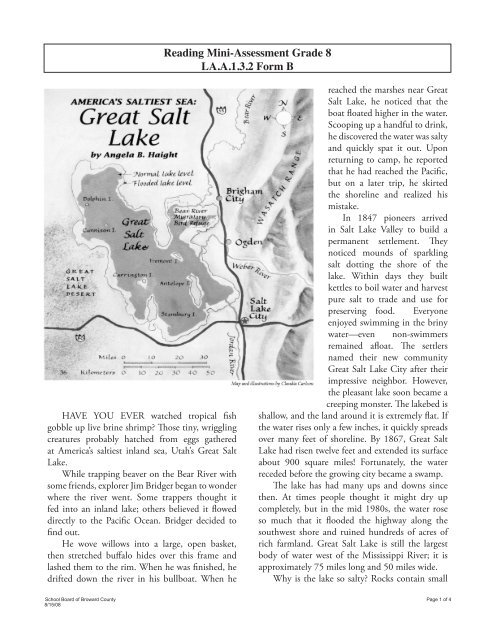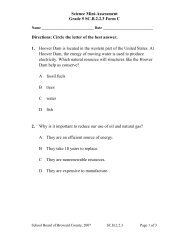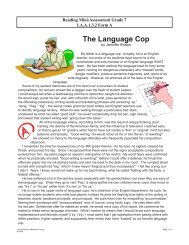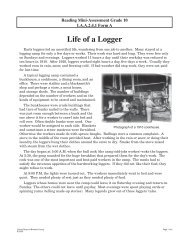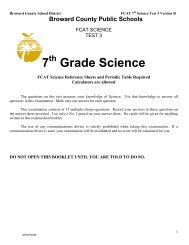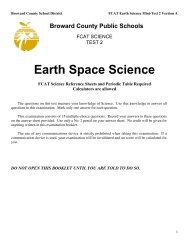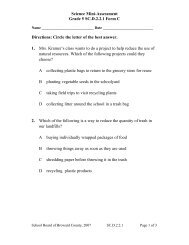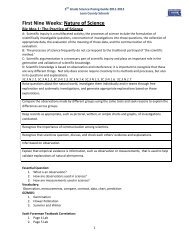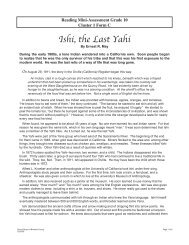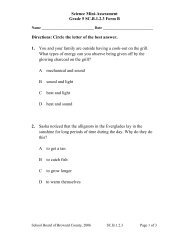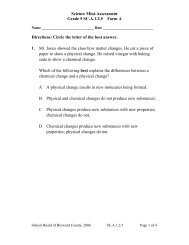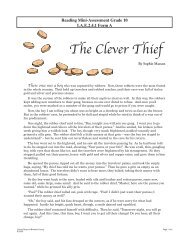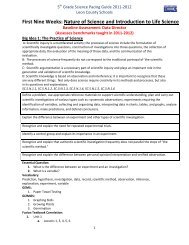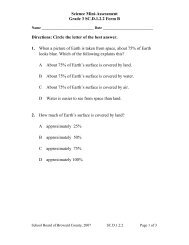Reading Mini-Assessment Grade 8 LA.A.1.3.2 Form B
Reading Mini-Assessment Grade 8 LA.A.1.3.2 Form B
Reading Mini-Assessment Grade 8 LA.A.1.3.2 Form B
Create successful ePaper yourself
Turn your PDF publications into a flip-book with our unique Google optimized e-Paper software.
<strong>Reading</strong> <strong>Mini</strong>-<strong>Assessment</strong> <strong>Grade</strong> 8<br />
<strong>LA</strong>.<strong>A.1.3.2</strong> <strong>Form</strong> B<br />
HAVE YOU EVER watched tropical fish<br />
gobble up live brine shrimp? Those tiny, wriggling<br />
creatures probably hatched from eggs gathered<br />
at America’s saltiest inland sea, Utah’s Great Salt<br />
Lake.<br />
While trapping beaver on the Bear River with<br />
some friends, explorer Jim Bridger began to wonder<br />
where the river went. Some trappers thought it<br />
fed into an inland lake; others believed it flowed<br />
directly to the Pacific Ocean. Bridger decided to<br />
find out.<br />
He wove willows into a large, open basket,<br />
then stretched buffalo hides over this frame and<br />
lashed them to the rim. When he was finished, he<br />
drifted down the river in his bullboat. When he<br />
reached the marshes near Great<br />
Salt Lake, he noticed that the<br />
boat floated higher in the water.<br />
Scooping up a handful to drink,<br />
he discovered the water was salty<br />
and quickly spat it out. Upon<br />
returning to camp, he reported<br />
that he had reached the Pacific,<br />
but on a later trip, he skirted<br />
the shoreline and realized his<br />
mistake.<br />
In 1847 pioneers arrived<br />
in Salt Lake Valley to build a<br />
permanent settlement. They<br />
noticed mounds of sparkling<br />
salt dotting the shore of the<br />
lake. Within days they built<br />
kettles to boil water and harvest<br />
pure salt to trade and use for<br />
preserving food. Everyone<br />
enjoyed swimming in the briny<br />
water—even non-swimmers<br />
remained afloat. The settlers<br />
named their new community<br />
Great Salt Lake City after their<br />
impressive neighbor. However,<br />
the pleasant lake soon became a<br />
creeping monster. The lakebed is<br />
shallow, and the land around it is extremely flat. If<br />
the water rises only a few inches, it quickly spreads<br />
over many feet of shoreline. By 1867, Great Salt<br />
Lake had risen twelve feet and extended its surface<br />
about 900 square miles! Fortunately, the water<br />
receded before the growing city became a swamp.<br />
The lake has had many ups and downs since<br />
then. At times people thought it might dry up<br />
completely, but in the mid 1980s, the water rose<br />
so much that it flooded the highway along the<br />
southwest shore and ruined hundreds of acres of<br />
rich farmland. Great Salt Lake is still the largest<br />
body of water west of the Mississippi River; it is<br />
approximately 75 miles long and 50 miles wide.<br />
Why is the lake so salty? Rocks contain small<br />
School Board of Broward County Page 1 of 4<br />
8/15/08
<strong>Reading</strong> <strong>Mini</strong>-<strong>Assessment</strong> <strong>Grade</strong> 8<br />
<strong>LA</strong>.<strong>A.1.3.2</strong> <strong>Form</strong> B<br />
quantities of salt that dissolve easily in the water.<br />
Rain or melting snow releases this salt and carries it<br />
into streams. Great Salt Lake is fed by three rivers,<br />
as well as several small streams and springs. In most<br />
lakes, salt is carried out as fast as it is brought in,<br />
keeping the water fresh, but Great Salt Lake has no<br />
outlet. Evaporation takes water out of the lake, but<br />
the salt stays.<br />
In dry years more water evaporates, and the<br />
lake shrinks and becomes saltier. During wet<br />
cycles, the lake grows and the water is less salty.<br />
Over the last century, Great Salt Lake has averaged<br />
25 percent salt. Ocean water is only 3 percent salt.<br />
Because the water is so salty, companies harvesting<br />
at Great Salt Lake can make salt faster and cheaper<br />
than those using ocean water. Great Salt Lake is<br />
not a beautiful, picture-postcard mountain lake. At<br />
first glance the landscape seems empty and barren.<br />
There are no trees on the shore, and to the west<br />
stretches an immense salt desert. The water itself<br />
is another kind of desert. Nothing but algae and<br />
brine shrimp can survive such a salty bath.<br />
But despite its barren appearance, the lake<br />
is far from dead. Its islands and marshes provide<br />
an important rest stop for migratory birds. The<br />
mouth of the Bear River, where Jim Bridger drifted<br />
into the lake, is a protected bird refuge. Over 200<br />
different species have been identified there as they<br />
travel between North and South America. Millions<br />
of brine flies living by the shore provide plenty of<br />
food. Some birds–California sea gulls, ducks, geese,<br />
and pelicans—return every summer to build nests<br />
and raise their young at Great Salt Lake.<br />
Without the sea gulls, Salt Lake City might<br />
have become a deserted ghost town. Food was<br />
scarce the first year after the pioneers hauled their<br />
wagons over the Rocky Mountains to the isolated<br />
valley. Trekking back to St. Louis for supplies took<br />
months, and without a good harvest, the settlers<br />
faced starvation. Their newly planted acres of<br />
wheat and corn looked promising. But one day,<br />
clouds of black crickets poured out of the foothills.<br />
They blanketed the fields, gorging on the tender<br />
green plants. The farmers tried to pick the bugs off,<br />
beat them, or even burn them, but it was useless.<br />
The insects swarmed across the valley, destroying<br />
everything in their path.<br />
Suddenly, large flocks of sea gulls appeared<br />
from their nesting grounds at the lake. The farmers<br />
watched in horror. Surely the birds would finish<br />
up anything the crickets missed. But instead of<br />
joining the destruction, the gulls began scooping<br />
up crickets. They returned time and time again,<br />
devouring the insects. Enough of the crop was<br />
saved for the settlers to survive another winter.<br />
That’s why the state of Utah honors the California<br />
sea gull as its official state bird.<br />
From that first small settlement in the valley,<br />
the population has expanded so that now more<br />
than a million people live north, south, and east<br />
of the lake. Urban growth has had little effect on<br />
Great Salt Lake, though. It is a unique geological<br />
feature and an unmistakable landmark on the map<br />
of the western United States.<br />
“America’s Saltiest Sea: Great Salt Lake,” reprinted by permission of Cricket Magazine, April 1996, Vol. 23, No. 8, © 1996 by Angela B. Haight, illustrations from the Utah Division of Wildlife.<br />
School Board of Broward County Page 2 of 4<br />
8/15/08
<strong>Reading</strong> <strong>Mini</strong>-<strong>Assessment</strong> <strong>Grade</strong> 8<br />
<strong>LA</strong>.<strong>A.1.3.2</strong> <strong>Form</strong> B<br />
Name __________________________________________ Date ___________________<br />
Directions: Read the passage “America’s Saltiest Sea,” then select the correct answer.<br />
1. Which two words from the passage are most nearly the same?<br />
A. promising, joining<br />
B. living, trekking<br />
C. scooping, destroying<br />
D. gorging, devouring<br />
2. When the author states, “Without the sea gulls, Salt Lake City might have become a deserted ghost<br />
town,” she is saying that the sea gulls<br />
A. were the only living things in Salt Lake City.<br />
B. kept Salt Lake City from being haunted.<br />
C. made it possible for the settlers to remain in Salt Lake City.<br />
D. were a source of food for the settlers in Salt Lake City.<br />
3. Read these sentences from the passage.<br />
But one day clouds of black crickets poured out of the foothills. They blanketed the fields,<br />
gorging on the tender green plants.<br />
What does the word blanketed mean in this sentence?<br />
A. flew over<br />
B. covered<br />
C. destroyed<br />
D. passed by<br />
4. Read this sentence from the passage.<br />
At first glance the landscape seems empty and barren.<br />
A barren landscape would most resemble<br />
A. a desert.<br />
B. a prairie.<br />
C. a meadow.<br />
D. a pasture.<br />
School Board of Broward County Page 3 of 4<br />
8/15/08
<strong>Reading</strong> <strong>Mini</strong>-<strong>Assessment</strong> <strong>Grade</strong> 8<br />
<strong>LA</strong>.<strong>A.1.3.2</strong> <strong>Form</strong> B<br />
ANSWER KEY – America’s Saltiest Sea<br />
<strong>LA</strong>.<strong>A.1.3.2</strong>: word structure, context clues, inferences, conclusions, organizational patterns<br />
1. Which two words from the passage are most nearly the same?<br />
A. promising, joining<br />
B. living, trekking<br />
C. scooping, destroying<br />
D. gorging, devouring<br />
2. When the author states, “Without the sea gulls, Salt Lake City might have become a deserted ghost<br />
town,” she is saying that the sea gulls<br />
A. were the only living things in Salt Lake City.<br />
B. kept Salt Lake City from being haunted.<br />
C. made it possible for the settlers to remain in Salt Lake City.<br />
D. were a source of food for the settlers in Salt Lake City.<br />
3. Read these sentences from the passage.<br />
But one day clouds of black crickets poured out of the foothills. They blanketed the fields,<br />
gorging on the tender green plants.<br />
What does the word blanketed mean in this sentence?<br />
A. flew over<br />
B. covered<br />
C. destroyed<br />
D. passed by<br />
Item #<br />
Answer<br />
4. Read this sentence from the passage.<br />
At first glance the landscape seems empty and barren.<br />
A barren landscape would most resemble<br />
A. a desert.<br />
B. a prairie.<br />
C. a meadow.<br />
D. a pasture.<br />
1. D<br />
2. C<br />
3. B<br />
4. A<br />
School Board of Broward County Page 4 of 4<br />
8/15/08


